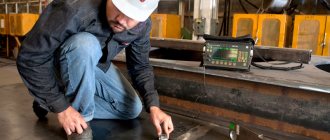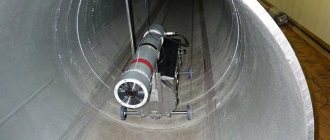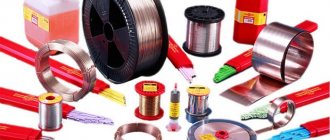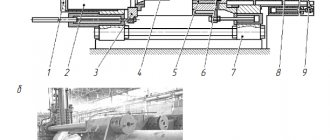Visual and measuring control in Yekaterinburg
RD_03-606-03
Visual and measuring testing (VIT) is one of the most cost-effective, fast and at the same time informative methods of non-destructive testing. This method is basic and precedes all other flaw detection methods in Yekaterinburg.
Despite the technical simplicity, a thorough approach to carrying out visual inspection involves the development of a technological map - a document that sets out the most rational methods and sequence of work.
How to carry out visual measurement control
VIC requires certain devices and experience of the controller, who must be certified based on training results to carry out such work. A process flow chart is developed in advance and used for work.
Sequence of visual-instrumental control:
- Preparing the connection for inspection . Cleaning and cleaning the surface.
- Preliminary inspection of the welded joint.
- Determination of seam roughness by tactile sensations.
- Studying the seam with optical devices.
- Measuring weld parameters . The work is done using a VIC kit. The use of templates and other tools allows you to study the seam more carefully:
- the length of the seam is measured;
- the leg of the deposited area is removed;
- the height and width of the seam are measured;
- The correct installation is checked and the parts are not displaced.
- An inspection report with the control results is filled out . It notes: identified defects, recommendations for the next inspection, tools used, performers. The act is saved along with the passport for this object.
Controlled objects:
Visual measurement control (VII) is used to check the quality of preparation and assembly of workpieces for welding, the quality of seams during the welding process, as well as the quality of the base metal.
Useful information: Visual measurement testing has been used much longer than other non-destructive diagnostic methods. It is simple and highly informative and does not require expensive equipment or special skills. But, to obtain more accurate information and detect hidden, intracavity defects, it is recommended to use VIC in combination with other non-destructive testing methods.
What defects in welded joints can be determined
Using VIC you can determine:
- quality of preliminary preparation of metal for welding;
- compliance of welds with the required standards;
- quality of metal that can be determined visually . This is, for example, a change in the color of the base metal, which may indicate either overheating during welding or another violation of the welding technology.
The visual method helps to identify:
- Before welding, the quality of edge preparation is determined;
- rust and burrs on prepared surfaces;
- defects on the surface of the part, cracks;
- presence of pores and uncooked areas;
- violation of the metal structure near the seam;
- corrosion;
- shells;
- bullies;
- seam offset from the connection line;
- defect in painting and coating (may indicate a hidden defect in the welding joint);
- hard inclusions in a weld alloy . They can be seen or identified by hand;
- The correctness of markings , marks of finished seams and their compliance with the given connection are checked.
Equipment used:
- Microscopes;
- Endoscopes;
- Borescopes;
- Video endoscopes;
- Set for visual and measuring control VIC (visual and measuring control set VIK-NDT);
- Magnifying glasses, including measuring ones;
- Metal measuring rulers;
- Test squares 90° pattern;
- Calipers, height gauges and depth gauges;
- Probes;
- Protractors with vernier;
- Wall gauges and indicator thickness gauges;
- Micrometers;
- Micrometric and indicator bore gauges;
- Calibers;
- Endoscopes;
- Templates, including special and universal (for example, UShS type), radius, threaded, etc.;
- Verification plates;
- Plane-parallel gauge blocks with a set of special accessories;
- Line length measures (steel measuring rulers, tape measures).
It is permissible to use other means of visual and measuring control, subject to the availability of appropriate instructions and methods for their use.
Important! Before starting VIC, it is necessary to treat the controlled area. The weld seam is thoroughly cleaned with a special metal brush. There should be no slag particles, scales, or splashes of molten metal on the surface. To obtain reliable results by visual measurement control, part of the surface under study must be cleaned to a shine.
Sets for visual and measuring inspection (VII)
Required Tools
The inspection area requires additional lighting. The inspector must have a flashlight to perform the inspection accurately.
If the connection point that needs to be inspected is located in places where it is not possible to carry out work, special platforms with installed video surveillance are used.
List of tools:
- Magnifiers.
- Lenses.
- Microscopes : used to inspect recesses and grooves.
- Video endoscopes.
- Borescopes.
- Squares.
- Calibers.
- Endoscopes : allow you to see hidden areas of a structure.
- Bore gauges.
- Line length measures.
- Protractors with vernier.
- Probes.
- Calipers.
- Thickness gauges.
- Micrometers.
- Universal welder templates . Serve to control the thickness of the seam.
- Test plates.
- Set for visual and measuring control.
- Laser scanner : reduces the influence of the human factor. The conclusion about the suitability of the seam is made immediately.
It is allowed to use tools not included in the list of RD 03-606-03, but provided that there are instructions and guidelines for their use.
Regulatory documents in Yekaterinburg:
RD 03-606-03. INSTRUCTIONS FOR VISUAL AND MEASURING CONTROL.
RD 34.10.130-96. GUIDANCE DOCUMENT. INSTRUCTIONS FOR VISUAL AND MEASURING CONTROL. CERTIFICATE SCIENTIFIC AND TECHNICAL .
GOST R 8.563-96. State system for ensuring the uniformity of measurements. Measurement techniques.
GOST 8.051-81. State system for ensuring the uniformity of measurements. Errors allowed when measuring linear dimensions up to 500 mm.
GOST 8.549-86. This standard establishes permissible errors in measuring linear dimensions up to 500 mm with unspecified tolerances during acceptance inspection.
EN 970:1997. European standard. Non-destructive testing of welds made by fusion welding. Visual control.
EN 13018:2001. European standard. Unbrakable control. Visual control. Part 1. General principles.
RD 03-606-03 Instructions for visual and measuring control
Expand ▼
The document has been canceled
since January 1, 2022 due to the publication of Decree of the Government of the Russian Federation dated 08/06/2020 N 1192.
The Instructions for visual and measuring control were put into effect by order of the Gosgortekhnadzor of Russia dated July 17, 2003 No. 156. This Instruction establishes the procedure for carrying out visual and measuring control of the base material and welded joints (surfacing) during manufacture, construction, installation, repair, reconstruction, operation, technical diagnosing (examination) of technical devices and structures used and operated at hazardous production facilities controlled by the State Technical Supervision Authority of Russia.
Contents I. Scope II. Terms and definitions III. General provisions IV. Personnel qualifications V. Requirements for visual and measuring equipment VI. Requirements for visual and measuring control 6.1. Preparation of work sites 6.2. Preparation for inspection The procedure for visual and measuring inspection at the stage of incoming inspection 6.4. The procedure for performing visual and measuring control of the preparation and assembly of parts for welding 6.5. The procedure for performing visual and measuring inspection of welded joints (surfacing) 6.6. The procedure for performing visual and measuring inspection of welded structures (assemblies, elements) 6.7. The procedure for performing visual and measuring inspection when eliminating defects in the material and welded joints (surfacing) 6.8. The procedure for performing visual and measuring control during operation, technical diagnostics (inspection) VII. Evaluation of control results VIII. Registration of control results IX. Safety requirements Appendix A. Terms and definitions of basic concepts. Appendix B. Requirements for the content of the program (plan, instructions) of incoming control Appendix B. Requirements for the content of the technological map of visual and measurement control Appendix D. Requirements for the content of the operational control map Appendix D. Approximate list of means of visual and measurement control Appendix E. Dimensional indicators for quality assessment standards based on the results of visual and measurement control Appendix G. Forms of documents drawn up based on the results of visual and measurement control.
Based on the results of visual and measurement control, the following are drawn up: 1. A journal of work and registration of visual and measurement control; 2. Act of visual and measuring control; 3. Certificate of visual and measuring quality control of welds during the welding process; 4. Sizing protocol.
VIC control is a professional service to guarantee quality
Having extensive experience and the necessary qualifications, our laboratory employees will most accurately and professionally perform the entire range of services aimed at controlling the quality of not only manufactured products, but also the raw material base (metal). Visual and measuring flaw detection during welding of products is carried out in several stages:
- Compliance with metal markings and its integrity;
- Correct assembly of product elements for welding;
- Visual quality control of seams.
If welding is performed in several layers, the seam joints are checked after each layer. If defects are identified, products are rejected. This professional approach can significantly improve the quality of a batch of goods and increase customer loyalty.
If you are not ready to risk your reputation and focus on the high quality of the products produced, we are ready to help. A professional laboratory accredited under the Gazprom system will become a reliable guarantor of your production.
Advantages and disadvantages of the VIC method
The advantages of this method include:
- Economical . No expensive equipment required.
- Accessible and informative method.
- No special training required in educational institutions.
- Efficiency . Organizes quickly.
- The method is easy to repeat.
Minuses:
- Possibility to examine only the visible part of the structure.
- Shows only visible defects.
- Subjective – human factor.
- Defects can only be recorded manually.








